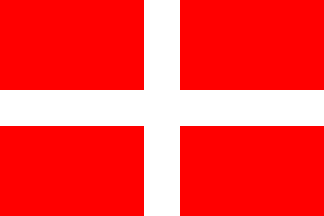
image by Željko Heimer, 8 June 2002

Last modified: 2006-03-18 by martin karner
Keywords: malta | europe | s.m.o.m. | sovereign and military order of malta | knights hospitallers | order of st.john | jerusalem | rhodes | maltese cross | italy | rome | amalfi | christian orders | christian | catholic |
Links: FOTW homepage |
search |
disclaimer and copyright |
write us |
mirrors

image by Željko Heimer, 8 June 2002
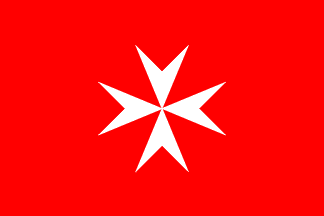
Grand Master Flag
image by Željko Heimer, 8 June 2002
On this page:
See also:
Other sites:
This humanitarian organization has agreed with the state of
Italy on a certain level of sovereignty in 1966, expressed mainly
in the issuing of stamps and coins. One should draw attention on
their stamps, since they are mostly heraldical and vexillological
(and history of art, but we are not dealing with that here?).
Most of the serious stamp dealers don't recognize those stamps to
be real stamps, but for vexi-freaks, they are quite interesting,
I dare say valuable source of (primarly) coats of arms. The Order
has its branches (missions) in many countries of the world, and
their stamps are recognized by 44 states (until 1994). However,
on some of the stamps there are images of the flag of the Order,
red with a white Maltese cross. On all the images the flag is
shown flying, so it is difficult to estimate the proportions. Is
seems to me that 1:2 is approximate enough.
Željko Heimer, 8 March 1996
Extracts from the St. John Ambulance Australia Cadet Manual
(3rd Edition) :
Seven years later [the Knights Hospitaller] were given the island
of Malta by the Emporer Charles V of Spain. ... The Order had
always contained people of different nationalities and was
organised into eight national 'Tongues', which were, in the
official order of precedence, those of Provence, Auvergne,
France, Italy, Aragon, England, Germany and Castile-Portugal.
The British occupation in 1800 (...) found the knights dispersed
and disunited. Subsequently, they established their headquarters
in Rome, where their claims to sovereign status are recognised by
more than thirty countries with which they maintain diplomatic
relations. This is exclusively a Roman Catholic and a religious
Order, known now as the Sovereign Military Order.
Jonathan Dixon, 24 September 1999
SMOM is sovereign and has diplomatic ties with a number of
countries, but it has no territory except a few buildings used
for administration.
Ole Andersen, 14 March 2001
The Soveriegn Military Order of Malta is a sovereign entity
according to international law, but is acctualy used as a classic
example of an entity which is sovereign (like a country) but is
not a country. It does not have a territory, and therefore, it
does not live up to the requisites of a country. A sovereing
entity does not have to be a country. SMOM is an example of this.
For sovereignity, it is generally considered that the entity
should recogniced as such by other sovereign entities.
Literature on the subject: R.M.M. Wallace: "International
Law", Sweet & Maxwell, 2nd edition, London 1992, page 76
Elias Granqvist, 14 March 2001
The case of the SMOM is an interesting matter. Different books
on international law give different explanation. Some countries
consider it as a sovereign organization, others consider it as a
country without territory, others consider it as the world's
smallest country. Whether it is a country or not depends on the
status of the headquarters of SMOM (a building and a garden -
6000 square meters). The headquarters have an extraterritorial
status, but it is not clear whether it is the territory of the
SMOM or it is the embassy of SMOM in Italy. In any of the two
cases, I think that the SMOM should be considered as a country,
as it have many of the functions of a country: it has diplomatic
relations with many countries, issues passports (only countries,
the Red Cross, and the UN issue passports), and is member of a
few international organizations.
Ivan Marinov, 14 March 2001
I have at hand a book, "Report from Practically
Nowhere" by John Sack, copyright 1955 et seq., published by
the Curtis Publishing Company, with chapters about visits to
Andorra, San Marino, Lundy, Liechtenstein, Sharjah, Athos, Swat,
Punial, etc., with a chapter about the S.M.O.M. wherein is stated
that, by agreement with the Italian government, citizens of the
S.M.O.M. are limited to three: the Grand Master, the Deputy Grand
Master, and the Chancellor. These carry S.M.O.M.
passports. The numerous other members of the order remain
citizens of their own respective countries.
John Ayer, 14 March 2001
The case of SMOM is similar to the Vatican's case in this
sense. The Vatican also has citizens (1500
persons), but there is nobody with only Vatican citizenship. For
example, the Pope is citizen of both the Vatican and Poland. The
other peculiarity is that the Vatican issues only diplomatic
passports, so this is a country, where all the citizens are
diplomats. SMOM has the same practice. A month ago there was a
scandal in Hungary with the chief of the humanitarian service of
the Hungarian branch of the SMOM. In the news there was the
following information: he was beaten in Romania and both his
Hungarian and his SMOM diplomatic passport were stolen.
Maxval, 14 March 2001
According to <www.smom-za.org>,
SMOM has diplomatic relations with 75 countries. It also has
permanent observer status at the UN and Italian recognition of
its extraterritorial rights over its properties in Rome. Given
the humanitarian activities of the SMOM, I'd guess that the value
in having it recognized as a sovereign entity is that it can be
seen as neutral, allowing SMOM into a war zone or wherever
doesn't have to carry the political baggage it might have if SMOM
were a corporation operating under the laws of Italy, let alone
the United States, for example.
Joe McMillan, 15 March 2001
John Ayer made reference to a 1955 book by John Sack titled
'Report from Practically Nowhere.' I had a chance to read this
book over the weekend, and while it's obviously somewhat - or
more than somewhat - out of date in much of its political
information, it's still a quite entertaining look at many of the
little, and little-known, micro-states of the world.
In the chapter on the Sovereign Military Order of Malta, Sack
mentions that the S.M.O.M.ians (as he calls them) ran a hospital
in Schleswig-Holstein, Germany, 'where, at first, the flags of
the S.M.O.M. were thought to be Denmark's by the
Schleswig-Holsteiner, who figured the Danes weren't up to any
good.'
Andrew S. Rogers, 9 April 2001
According to the UN's official site <www.un.org>,
SMOM maintains a recognized permanent observer mission in New
York. SMOM is not categorized by the UN as a non-member state
(like e.g. the Holy See) but among "entities and
intergovernmental organizations having received a standing
invitation to participate as observers."
Joe McMillan, 15 May 2002
My DK flag book says that the "Order of St. John"
flies a reverse English flag (my description) in Britain, but the
Maltese cross in Rome. Is this correct? If so, are the Sovereign
Military Order of Malta and this Order the same thing?
Nathan Lamm, 29 July 2002
Two different orders. After the Reformation, several of the
branches of SMOM were completely Protestant, so they left SMOM,
but kept on doing more or less the same. There is a formal
cooperation between these orders nowadays, in part to keep more
or less phony orders from infringing on the accumulated goodwill.
Ole Andersen, 29 July 2002
The SMOM is the Order of St. John, however in England (and the
Commonwealth and even the US) the order which claims descendancy
from the Order of St John (in particular, from the Enlish Langue
of the Order) is the "Most Venerable Order of the Hospital
of St. John of Jerusalem" which was granted a royal charter
by Queen Victoria, and from which springs St. John Ambulance in
all its various forms. See St. John
Ambulance. The flag of this order is the "reversed
English flag" (the cross of St. John) with the Queen's crest
in the canton.
Jonathan Dixon, 29 July 2002
The Sovereign Military Order of Malta is a sovereign entity in
international law, with diplomatic missions to 92 countries and
permanent missions to the UN, the European Commission and other
international and multinational organisations.
The Order's continued sovereign status derives from its
established acceptance as such by other sovereign states, rather
than from its possession of an extensive national territory. As
such, it is an unusual example of a sovereign international
entity, similar to the Vatican City State. The extraterritorial
seat of the Order is in Rome.
Peter Martinez, 21 December 2002
SMOM is the remnant of the Order of Malta which had
territories in Mediterranea : Palestine, Rhodes,
Aegean Sea, Malta, etc. And it has at least 2 territories: The
Palace of Via Condotti in Rome and the Fort Saint Angel given by
the government of Malta a few years ago.
Jean-Marc Merklin, 28 December 2002
The present "territories" of SMOM are not considered
territory any more than an embassy of a foreign contry is
considered its territory in any country. Thus, SMOM does not have
a territory.
Elias Granqvist, 28 December 2002
The SMOM also ruled the island of St. Croix in the Caribbean
from 1651 to 1665.
Ned Smith, 29 December 2002
I've taken a look at the order's own website and other
references and as far as I can tell SMOM itself does not claim to
be a state. It describes itself not as a state but as a
"sovereign subject of international law." That
seems to mean that it can make treaties, etc., but it apparently
acknowledges that it has no territory or people of its own.
As someone has noted, its facilities in Rome and elsewhere have a
status equivalent to that of an embassy. An embassy
possesses sovereign immunity from the jurisdiction of the host
state, but it is not actually part of the territory of the
sending state. Apparently the logic of the SMOM position is
that the Order has always had sovereign status independent of
whatever territories it may or may not have occupied from time to
time. If it had been a state, its sovereignty would have
been extinguished when its home territories were conquered, as
happened on three occasions. SMOM is a legitimate and highly
praiseworthy organization and is widely recognized as possessing
sovereign status (useful in fulfilling a nonbelligerent honest
broker's role in wartime situations). It just isn't a
"state."
There are other Orders of Malta besides SMOM, some of which are
reasonably legitimate successors of the original order (the
Protestant branches in Germany, Sweden, and the Netherlands, for
example); one of which (in the UK) has a questionable lineage but
is recognized by the British crown and, like SMOM, conducts
important humanitarian operations, especially ambulance services;
and many of which are entirely fraudulent or recreational,
mainly, I believe, here in the United States.
Joe McMillan, 29 and 31 December 2002
The flag of the Sovereign Military Order of Malta, abbreviated
to the Order or SMOM, is a red flag with a white Latin cross.
There are several books about the Order. Recent ones include:
H.J.A. Sire - The Knights of Malta - Yale University Press, ISBN
0 300 05 502 1 and Rosita McHugh - The Knights of Malta 900 Years
of Care - The Irish Association of the SMOM, Dublin ISBN 0
9525810 0 0.
from an answer to Jaume Ollé, 30 March 1997
This flag is shown in Album des Pavillons, but with
proportion 3:4, and labelled "Flag of the Order". The
flag with the white Maltese cross on a red field is the flag of
the Grand Master in Rome, very similar
to the Maltese Republic civil ensign
(same with a white border).
Ivan Sache, 17 April 1999
At Expo'98 this summer in Lisbon (both at the fairground and
in all the printed material I saw), the flag of the Grand Master of the Order - red with
white maltese cross in the center) was in display, and not the
Above one (red with white cross trhoughout).
Antonio Martins, 5 may 1999
I seem to recall that the cross existed as a heraldical charge
associated with the Order of the Knights of Saint John long
before their seat was established at Malta.
Santiago Dotor, 28 September 1999
In "Flags in South Africa and the world",
Proceedings of the XVIIth International Congress of Vexillology,
there is a rich paper by Adrian Strickland, entitled:
"The vexillological heritage of the Knights of Saint-John in
Malta" (pp. 277-287). According it , the flag and ensign of
the Order proportions should be 2:3 and width of the cross arm
1/5th of the hoist width. The Order's flag is called in Maltese
"Ir-Religjon"
Ivan Sache, 28 Febuary 2000
When I visited Prague, I passed next to SMOM embassy. I have
the flags that was hoisted there on video. I checked it again to
make sure. In the two entrances and on the building itself there
are the same flags, but those are not the flag on top but the Grand Master of the Order (by Antonio
Martins) flag . Since the grand master doesn't live in
Prague it seems that something is wrong here.
Dov Gutterman, 8 March 2000
The book "Hospitallers - The History of the Order of St.
John" doesn't actually mention a flag, but has many
illustrations of paintings showing the use of the plain white
cross on red. There are also a few examples of a white cross with
the ends of the arms splayed on red.
Apart from this, there is also a map dating fromc 1722-36 which
includes a panel containing the coats-of-arms of the grand
masters, supposedly from 1118., reengraved to include 4 more
grand masters after the original drawing of the map. (BoAs of
some of these are also seen in other illustrations). The first
CoA depicted is the white cross on red, and is labelled 'Croise
de la Religion'. The rest have the white cross on red in the 1st
and 4th quarters. The map itself is at the museum at St. John's
Gate, Clerkenwell (UK).
The book also names the SMOM as 'The Soveriegn Military and
Hospitaller Order of St. John of Jerusalem, called of Rhodes,
called of Malta' as opposed to the 'of Jerusalem, Rhodes and of
Malta' or 'of Jerusalem, Rhodes and Malta' alternatives
Jonathan Dixon, 11 March 2000
Recently I've find the web page <www.smom.org>
with a photo of the SMOM prince and grandmaster Andrew Bertie
signing some international document (and sittin next to
representative of Mosambique). In front of him, the red flag with
the white "Maltese Cross" is displayed.
Moreover, article No. 6 of title I of the Constitution of SMOM
says: "Par. 1 - The flag of the Order bears either the white
latin cross on the red fiels or the white eight-pointed cross
(cross of Malta) on the red field."
Are there two flags of the same status?
Jan Zrzavy, 21 July 2000
During my visit to Prague, I saw the Embassy of the Sovereign
Military Order of Malta. Correctly as in SMOM's Constitution,
there are two flags by the sides of the entrance gate (both
probably 2:3):
left - red flag with white Latin cross;
right - red flag with white Maltese cross.
It seems that SMOM (BTW, it is a subject to international law
ruled by the prince, in other words, SMOM is a "state")
has indeed two variant flags.
Jan Zrzavy, 4 March 2001

image by Gvido Petersons (Courtesy of Embassy of SMOM in
Latvia), 8 March 2001
Yesterday I've received two images from the Embassy of SMOM in
Latvia. I've asked the embassy for pictures of "flag and CoA
for representation of SMOM in encyclopedia". Here are both
CoA and flag (red flag with the white "Maltese Cross"),
courtesy of Embassy of SMOM in Latvia.
Note, the Embassy fly flag with plain white cross.
Gvido Petersons, 6 March 2001
According to [pay00] - Flag of
the Order (2:3) - Red flag with white cross throughout. Album
does not give FIS dots (just as well, they are meant for national
flags and like, while SMOM flag is difficult to set among these,
but this is an other issue), but if one would insist then CSW/CSW
would be appropriate, I guess. The upper line C is unquestionabl,
I guess (any member of the order could use it). S also, all Order
bodies use it, while W is questionable - though the Order is
military and their "army" use this same flag as well.
For use on seas - I question the C-use - there is, as far as I am
aware no civilian (merchant) fleet of the Order. However, there
might be "state" vessels for S, and these would also be
W in a way. Anyway, most of this is just theoretical issue.
The Order seem to choose to show the two flags (flag of the Order
plus the flag of the Grand Master) together whenever there is
chance to showing two flags. Only when there is need for just one
flag, the flag of the Order is choosen as a rule. We show also
both flags, but it should be noted clearly tehre that the other
is the flag of GM.
Željko Heimer, 8 June 2002
I think there are three different flags:
1. national flag version #1 (Latin cross)
2. national flag version #2 (Maltese cross)
3. grand master flag (Maltese cross with a chain. see Grand Master of the Order).
Jan Zrzavy, 8 June 2002
.gif)
image by Gvido Petersons (Courtesy of Embassy of SMOM in
Latvia), 6 March 2001
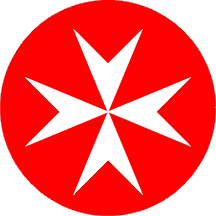
image by Željko Heimer, 8 June 2002
According to [pay00] -
Aircraft Marking - The roundel is a red disk with a white Maltese
cross, the round version of the Grand Master's flag (i.e. of the
Coat of Arms). These aircrafts are mainly used in humanitarian
missions of the Order, I understand. Also, here I may note the
rail-road waggons belonging to the Order which are marked with the
(lesser) Coat of Arms. The waggons are used also for humanitarian
missions, but also as emergency shelters for refugees in need.
Željko Heimer, 8 June 2002
[cos98] report:" Aircraft
of the independent sovereign order of Malta, based in Rome, have
occasionally carried the order's cross insignia on the fusalage,
retaining standart Italian roundels on the wings". The plate
shows something like the above but with the cross touching the edges
and all roundels bordered in yellow.
Dov Gutterman, 25 June 2004
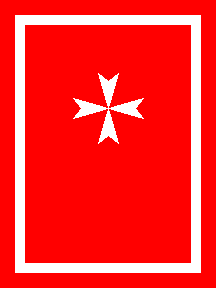
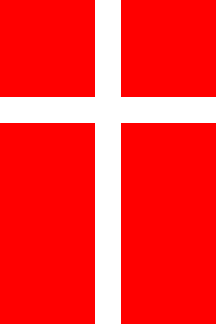
by Jorge Candeias, 4 March 2001
Could it be that the SMOM runs churches?
I'm asking because when one of the portuguese bishops retired,
there was a news item on him, with interview and some footage of
him after retiring, and at a point of the interview the man
entered a large church or cathedral (I don't know where, but at
that point the off-voice was talking about the portuguese city of
Beja) that had large vertical flags hanging at the door. One was
a wite Maltese cross on red (also with a white and red border)
and the other a white Latin cross on red.
Jorge Candeias, 4 March 2001
Alternatively, could the bishop have been a member of the
SMOM, and might the flags have been displayed in compliment to
him? Was the visit to the church part of a special
ceremony?
John Ayer, 5 March 2001
Well, the man was dressed in simple priest clothes (black
jacket and pants, grey shirt with white collar), not in the
shining bishop "dress", and the church was nearly
empty, so I don't think there was a ceremony there. Actually, he
behaved a bit like a tourist, so I'm not even sure it was taped
in Portugal.
In any case, your two other hypothesis (that he's a member of the
SMOM and the the flags are hanging for him) cannot be excluded.
Or that in that day some SMOM member visited the church. I just
don't know.
Jorge Candeias, 5 March 2001
In relation to the discussion about the existence of maltese
churches in Portugal, I can inform you that there is one church
in Lisbon who flies the other flag of the order (white maltese
cross on red) whenever I pass through it. It's the Church of St.
Luzia and St. Brás, in the Lg. de St. Luzia. The church also
displays maltese crosses as archtectural ornaments on the
outside. I never went inside though, so if there are any flags
inside I wouldn't know.
João Madureira, 10 May 2003